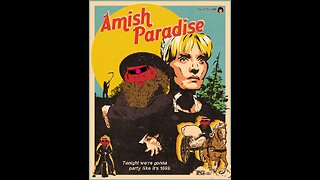Premium Only Content

Biography of Saif ur Rahman | آخوندزادہ پیر سیف الرحمن مبارک کی سوانح حیات اور ان کا مقبرہ
@islamichistory813 #Sufism #IslamicScholar #PeerSaifurRahman
Biography of Scholar Akhundzada Peer Saif ur Rahman Mubarak and his tomb
Dekhti Aankhooon aur sountay kaanoon ko Asslamoalaikum, In This Islamic video presents a comprehensive biography of Akhundzada Peer Saif ur Rahman Mubarak, a prominent Islamic Sufi scholar known for his profound contributions to Sufism and Islamic teachings. Viewers will describe his early life, spiritual journey, and the impact of his teachings on contemporary Islamic thought. Watch complete video as we are describing into the life and legacy of this revered figure in the Sufi tradition.
Akhundzada Peer Saif ur Rahman Mubarak also known as Mubarak Sahib was a Sufi scholar of the Naqshbandi Tariqa, the founder of the Saifia sect. He adhered to the Hanafi school of thought (Madhhab), the Maturidi creed (Aqidah), the Naqshbandi order (Tariqa).
He is known for the gatherings of Zikr (Remembrance of Allah) he has held. Through him many people have accepted Islam. His followers observe strict compliance with Sunnah and practice Zikr regularly.
He was born in a small village named Baba Kalai, about 20 km (12 mi) from Jalalabad on Muharram 20, 1344 AH (August 10, 1925 CE). His father, Sufi Hafiz Qari Muhammad Sarfraz Khan, a disciple of Sheikh Haji Muhammad Amin, a sheikh from Qadiriyah sufi order.
Akhundzada Saif ur Rahman Mubarak's basic education from his father included Quran study. When he was 13 his mother died. For formal religious education, he moved to Peshawar in the early 1940 and stayed there for many years, gaining knowledge of Tafseer, Hadith, Usul al-fiqa, Aqida and Tajwid.
After completion of his education he returned to Afghanistan, living in Kunduz. He was allotted land by the Afghan Government in Archi. Akhundzada Saif ur Rahman Mubarak, now a religious scholar, constructed a mosque and himself became Imam and Khateeb of the mosque. He also started offering free Dars-e-Nizami courses to the students, both beginners and advanced.
During his stay at Archi, Akhundzada Saif ur Rahman Mubarak, who had developed a special interest in Sufism and had resorted to private study for a conceptual understanding of the subject, met Naqshbandi sheikh and Sufi scholar Shah Rasul Thaqalayni; he requested Bay'ah. He was instantly granted Bay'ah in Naqshbandi order, and at that time he was 32 years of age.
Shah Rasul Thaqalayni being an old man had instructed his Salikeen (disciples) to remain in the company of his favorite murid, Maulana Muhammad Hashim Samangani, after his departure. He died in 1381 A.H. Following the instructions of his sheikh, Akhundzada Saif ur Rahman Mubarak got bay'ah from Samangani, who renewed the zikr and started guiding Akhundzada Saif ur Rahman Mubarak in his spiritual journey.
Maulana Hashim Samangani, in 1387 A.H., fell ill and called for Akhundzada Saif ur Rahman Mubarak, who had been granted limited Khilafat, to share the responsibilities of training the other salikeen. This not only provided the opportunity to Akhundzada Saif ur Rahman Mubarak to enjoy the company of his Murshid, but also gave an implicit indication of his superiority over other Salikeen, by the Murshid. Akhundzada Mubarak performed his duties with such vigour and sense of responsibility that his Murshid gave him Mutliq (autonomous) Khilafat.
He spent three years in service of his Murshid after which he was directed to Sheikh Haji Pachero for training in the Qadiriyah. Soon he was bestowed with Khilafat of that order too. He then went to Nowshehra, Pakistan, where he spent some time and imparted coaching to the salikeen in the vicinity. After some time, he returned to Afghanistan and traveled in various parts of the country including Nangarhar, Jalalabad, and Laghman. On instructions by his Murshid, Akhundzada Saif ur Rahman Mubarak returned to Archi where he remained busy spreading the essence of the religion.
Maulana Hashim Samangani died in 1391 A.H. Before his death, he had ordered all his disciples to keep the company of Akhundzada Pir Saif ur Rahman Mubarak. In 1398 AH Akhundzada Mubarak performed Hajj. He also visited Madinah and visited various regions on his journey back to Afghanistan.
Akhundzada Saif-ur-Rahman Mubarak decided to leave Afghanistan in 1978 prior to the Soviet–Afghan War for his murshid who rested in Pir Sabaq, a small town near Nowshehra, where for three years he provided religious guidance. In 1409–1410 A.H., Afridi tribes of Bara offered him land for a meeting house, which he accepted. At this juncture, the Saifi order originated. He built a mosque, Dar-ul-Ulum, and Khanqah for a place where he could continue the spiritual training of his disciples.
In Bara his preaching was opposed by Mufti Munir Shakir, a Deobandi cleric, backed by activists of his armed group, Lashkar-e-Islam, who had earlier been expelled from Kurram Agency by the Political Agency due to his active involvement in sectarian violence and who resorted to violence against Pir Saif ur Rahman Mubarak including initiation of FM-based propaganda attacking and burning property
So sisters brothers friends and elders, tomorow we will be described Biography of Sufi Abu Abdullah Muhammad ibn Sa'id al-Busiri al-Sanhaji. Allah hafiz
=================
-
 5:09
5:09
ISLAMIC HISTORY
20 hours agoSpiritual Healing for Diseases Through Surah Al-Fatiha بیماریوں کا روحانی علاج سورہ فاتحہ کے ذریعے
1 -
 28:01
28:01
Side Scrollers Podcast
7 hours agoNEW SERIES! Smash JT Has a Full-On Meltdown | Nerd Duel ft. Lady Desiree & You, Me & The Movies
35.9K2 -
 2:13:28
2:13:28
I_Came_With_Fire_Podcast
9 hours agoMEAD & MENTAL HEALTH WITH I CAME WITH FIRE AND VOC!!!
54.6K4 -
 1:10:04
1:10:04
John Crump Live
6 hours ago $5.56 earnedYes I talked To The ATF
41K3 -
 6:01:28
6:01:28
Amish Zaku
9 hours agoVerDanceKey Warzone - Birthday Fun
47.2K5 -
 5:15:22
5:15:22
NeoX5
6 hours agoKhazan: The Road Less Taken | Part 5-2 | Rumble Studio | Rumble Gaming
39.5K1 -
 LIVE
LIVE
TwinGatz
12 hours ago🔴LIVE - He Is Doing His Best | ARMA Reforger
796 watching -
 54:40
54:40
LFA TV
16 hours agoSee God in the Trade War | TRUMPET DAILY 4.7.25 7PM
65.1K15 -
 1:18:30
1:18:30
Sarah Westall
9 hours agoNew Study: EMFs Literally Put You into a Brainwave Cage; Reclaiming your Mind w/ Ian & Philipp
78.6K22 -
 35:54
35:54
SantaSurfing
10 hours ago4/7/2025 - Trump Tariff impacts - he wants no Capital Gains Tax! Inflation falls to 1.22%!
48K35